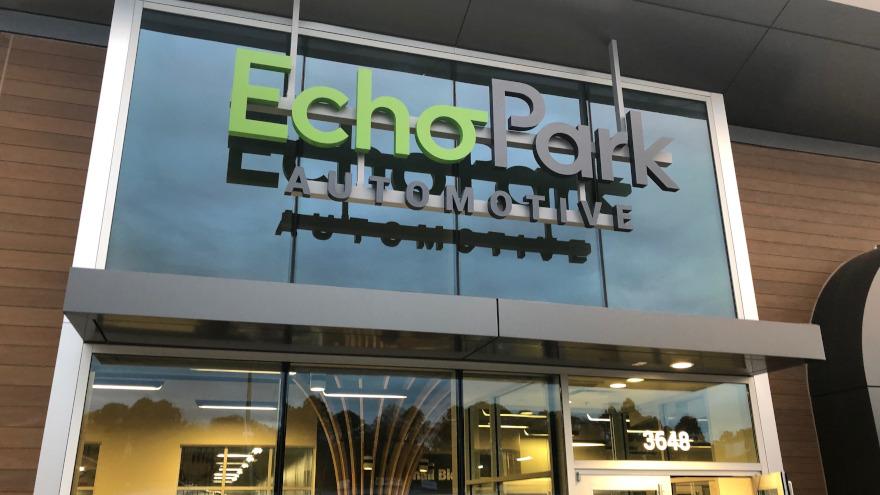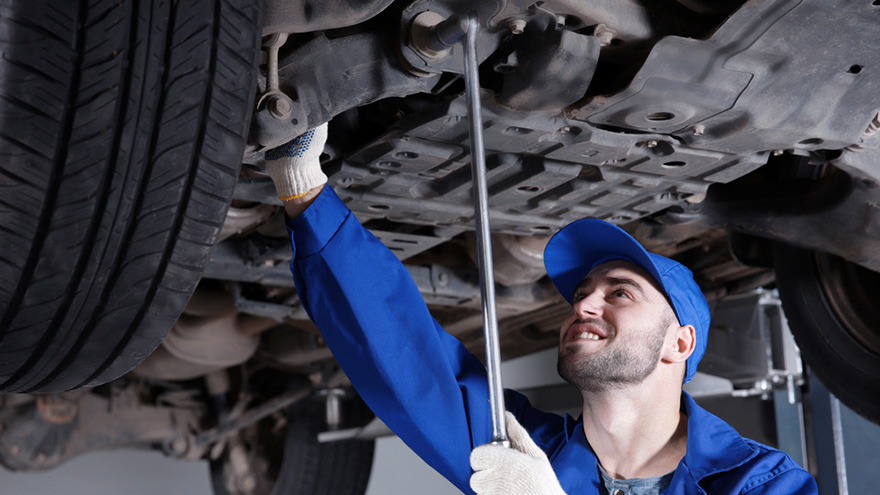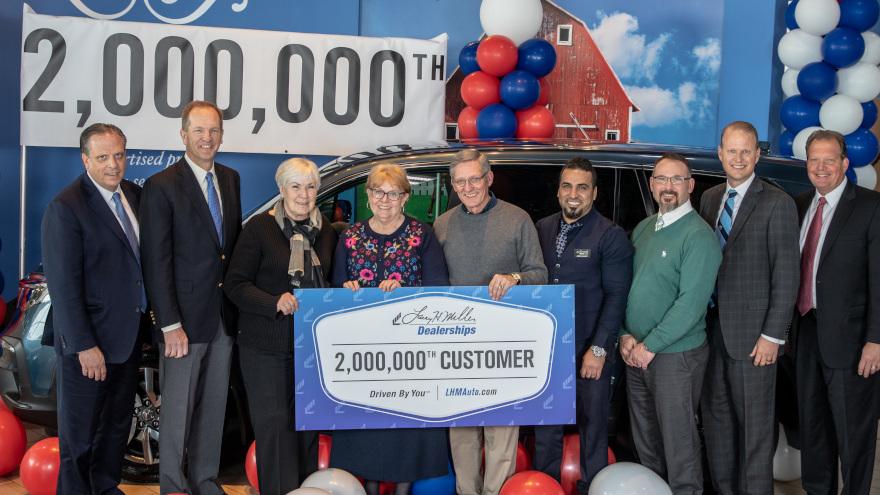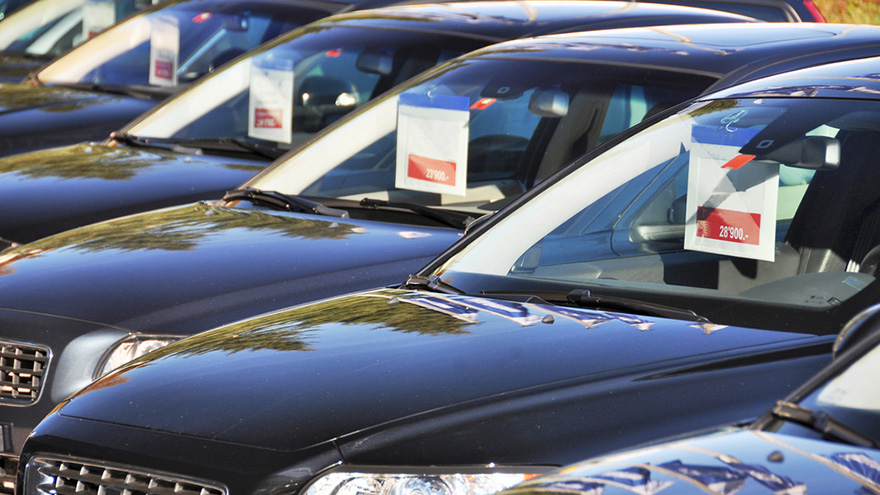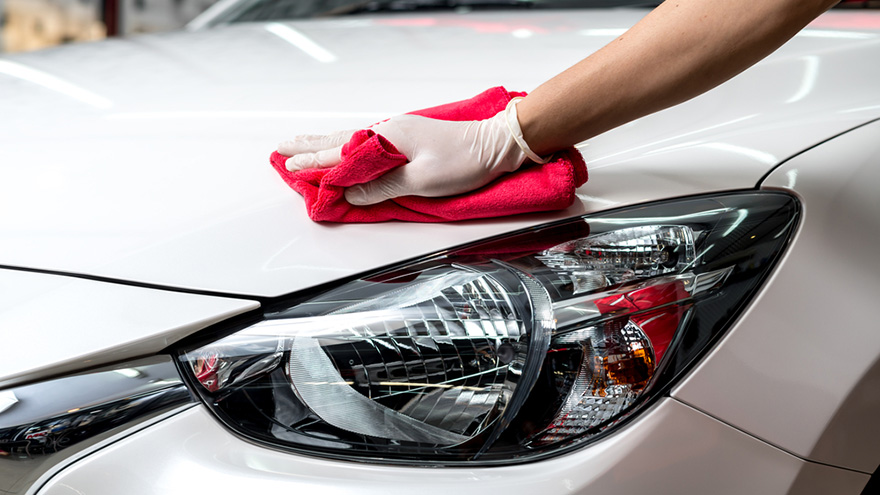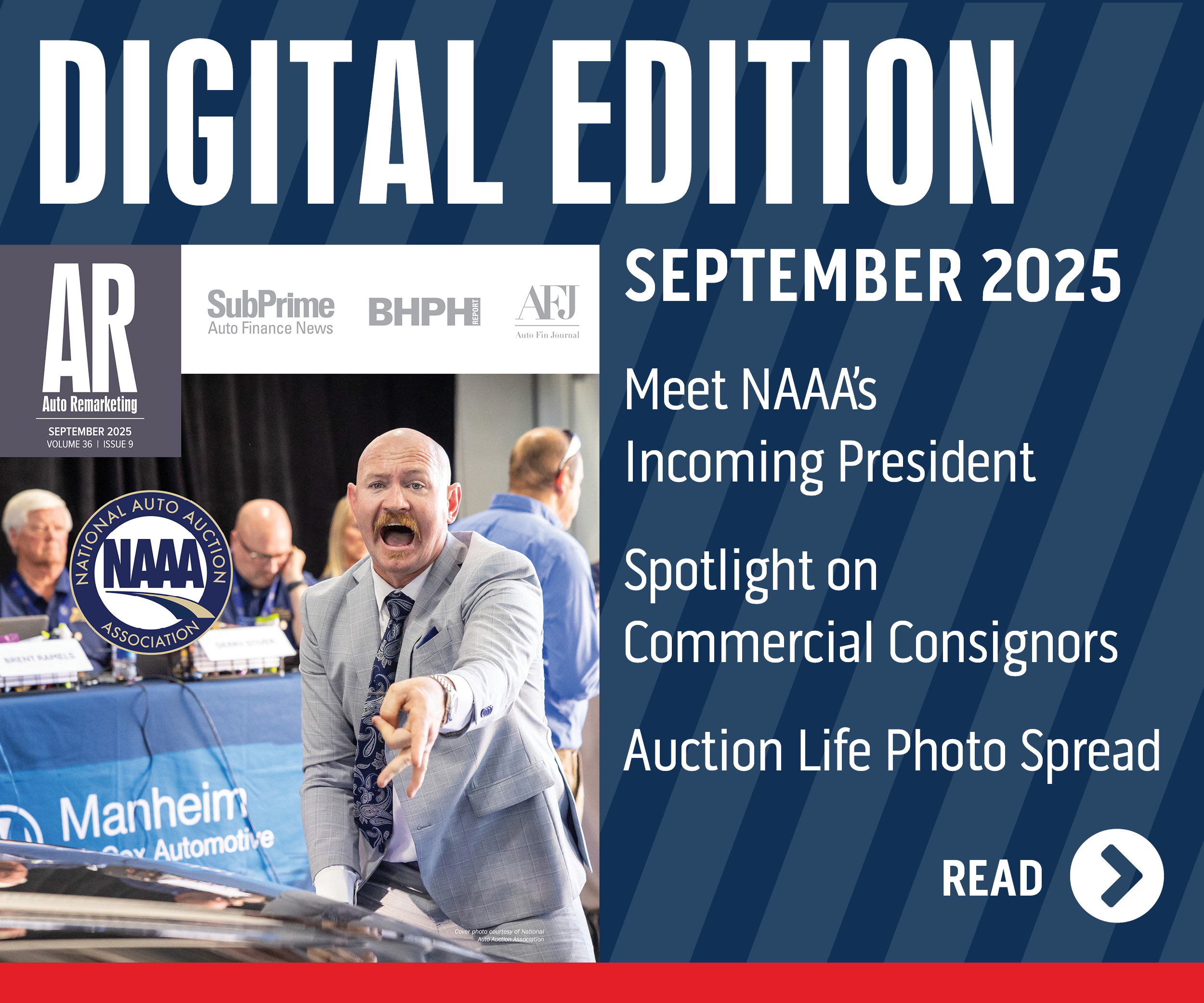Sonic Automotive’s EchoPark program has turned a corner in a big way.
The retailer’s line of standalone used-car stores is now profitable and should break $1 billion in revenues this year, Sonic said Thursday in reporting financial results for the first quarter.
And the dealership group’s leadership believes its EchoPark operations will eventually outpace its franchised dealerships in terms of volume and profitability.
In Q1, EchoPark generated $249.6 million in revenue, an 89.8% year-over-year increase.
Pre-tax profit for EchoPark was $14,9 million in Q1, compared to $14.7 million in pre-tax loss a year ago.
The standalone used-car stores had $5.0 million in positive cash flow (Adjusted EBITDA) during the quarter, up $8.3 million year-over-year.
“We are very pleased with the results for the quarter with our franchised dealerships offering a solid performance and EchoPark beginning to show what is possible from what we have developed over the last several years,” David Smith, who is chief executive of both Sonic and EchoPark, said in a news release.
Amid the stores “still maturing,” EchoPark revenue should top the billion-dollar threshold this year, Smith said, pointing out that nearly 29% of Sonic’s consolidated used-car unit sales in Q1 came from EchoPark.
“This is currently being accomplished through eight locations that serve a multitude of surrounding markets across the United States. As we expand our footprint into other areas across the country, we believe EchoPark will exceed the overall volumes and profitability of our franchised dealerships,” Smith said.
“We believe the combination of our customer-centric shopping experience, high quality vehicle offerings, rock-bottom pricing and transparent trade-in appraisals is disrupting the pre-owned markets that we serve,” he said. “At our EchoPark stores, we continue seeing the markets we serve expand as customers have recognized the value we offer and are traveling hundreds of miles to purchase their vehicle from EchoPark.”
Sonic and EchoPark president Jeff Dyke, who has talked extensively with Auto Remarketing about EchoPark in the past, said in Thursday’s release he was pleased with operations of both in Q1, calling the quarter “one of our best starts to a year that I can remember.”
As for the standalone stores, Dyke said: “Our EchoPark operating model has evolved over time as we continue to listen to what customers want when shopping and buying a pre-owned vehicle. Of course, customers want it to be an easy, transparent process where they get a quality product at a great price.
“It sounds simple, but the magic is when you can give customers exactly what they want and make money doing it. Our EchoPark stores offer a unique and customer-friendly buying experience from the time customers first type in EchoPark.com on their computer or mobile device, to the moment they sign that last document electronically so they can begin to enjoy their car or truck,” Dyke said.
“We provide an exceptional guest experience and value pricing along the lines of what Costco does for its customer base, while managing inventory days' supply well below industry norms. Our proprietary inventory management and pricing tools that we have invested in for years are really paying off,” he said.
EchoPark had more than 11,000 unit sales in Q1 (up 100.3%), Dyke said, with all-in days’ supply below 30 days and a front-line inventory days’ supply of less than 20.
“This model allows us to remain very flexible and take advantage of inventory availability and valuation shifts in order to keep our pricing well below our competition,” Dyke said. “We believe in keeping our operating expenses very low so we can offer our guests the best pricing and guest experience in the industry today."
In a late November interivew at the Charlotte, N.C., EchoPark location, Dyke discussed how establishing a rhythm in buying is key in inventory management for EchoPark. So is consistency. Buying to a number. And not over-buying.
“You’re going to sell more cars on a Saturday than you do on a Thursday, but we know those rhythms, so we buy in conjunction with that,” Dyke said during that interview. “And we try not to over-buy; we do have projections for what we think we’re going to sell the next week, and we try to buy to that number. And then the next week, buy to that number.
“Everything is done by week, so that we keep a consistent flow of inventory. And that’s critical. Inventory management is imperative in order to be able to be profitable in a store like this.”
On the financial side, Sonic and EchoPark executive vice president and chief financial officer Heath Byrd said in Thursday's news release that the expansion plans for the standalone store chain could bring in incremental revenues between $500 million and $1 billion annually, based on EchoPark’s current performance.
“We believe the improved strength of our balance sheet and the positive cash flows from our EchoPark and franchise operations will allow us to fund the expansion of EchoPark internally without the need to access capital from the public markets,” Byrd said.
Smith, the Sonic and EchoPark CEO, recapped several of the hallmarks the standalone stores achieved during the quarter.
“There were several 'firsts' for the EchoPark operations during the quarter beyond the unit and revenue growth we have become accustomed to seeing. Two of the more significant 'firsts' relate to positive cash flow and profitability. Adjusted EBITDA for EchoPark was $5.0 million during the quarter,” Smith said.
“At the EchoPark store operating level, the contribution of Adjusted EBITDA during the first quarter was $6.1 million, offset by negative corporate level Adjusted EBITDA of $1.1 million. For the other significant 'first,' the pre-tax results for EchoPark were $0.2 million for the first quarter of 2019,” he added.
“This is the first quarter of profitability for the entire business unit. Operationally, it performed even better than the $0.2 million, as this amount includes an impairment charge of $1.9 million. Absent the impairment charge, EchoPark posted a pre-tax profit of $2.1 million. We look forward to sharing more of these 'firsts' with everyone in the future.”
The segment of the nation’s economic engine fueled by franchised dealerships ran pretty smoothly last year.
In fact, employment and payroll at U.S. franchised dealerships continued to rise in 2018, according to the latest report released on Monday by the National Automobile Dealers Association.
In 2018, the nation’s 16,753 franchised dealerships employed 1,136,600 workers, up 0.5 percent from the previous year, according to NADA Data 2018.
“Direct employment at new-car dealerships once again topped 1.1 million employees at the end of 2018,” NADA senior economist Patrick Manzi said in a news release. “In addition to direct employment provided by new-car dealerships, hundreds of thousands of other jobs in local communities are dependent on dealerships.”
The report indicated payroll at franchised dealerships topped $66.5 billion in 2018, up 1.9 percent from the previous year. On average, dealership employees earned $1,134 per week, up 1.8 percent from 2017.
“For the past several years, dealership employees have seen steady increases in their incomes as well as their total compensation,” Manzi said. “Dealership jobs offer compensation that is significantly higher than other retail sectors, and dealers continue to boast one of the highest average salaries of all industries.”
Other highlights from NADA Data 2018 include:
— For the second consecutive year, total sales which includes new- and used-car sales, service, parts, F&I and more topped $1 trillion.
— At the end of 2018, the average selling price of a new and used vehicle sold at franchised dealerships was $35,608 and $20,586, respectively.
— Net pre-tax profit per dealership as a percentage of total sales (new and used vehicle sales, service, parts, F&I and body shop) continued to decline: 2016 (2.5 percent); 2017 (2.3 percent); and 2018 (2.2 percent)
—Since 2009, service and parts sales on average per dealership increased by 5.5 percent per year on an annualized basis.
NADA Data 2018 also includes a section focusing on the new- and used-vehicle financing with in-depth data from Experian. The stats include average monthly payment, average contract term, leasing and more.
To download the entire report, go to this website.
Used cars were always a major point of emphasis for Larry H. Miller.
Miller, who founded Utah-based Larry H. Miller Dealerships in 1979, expected his business’ used-to-new vehicles sales ratio to be at 1-to-1.
Miller died in 2009, but the company has continued to operate on his philosophy of the importance of used vehicles.
“The impact of a solid used-car operation within our dealerships is critical to our overall success,” Rod Rowley, who is vice president of operations for the dealer group, said via email.
Other dealership groups agree with that thinking. Penske Automotive Group reported record full-year and fourth-quarter 2018 adjusted results, and for the year those record results included units retailed, revenue and earnings before taxes. Used vehicles played a major role in that success.
“For the fourth quarter, our business was driven by continued growth in used vehicles, service and parts, the commercial truck operation and our equity investment in Penske Truck Leasing,” company chairman Roger Penske said in the company’s full-year and fourth-quarter 2018 earnings release.
Larry H. Miller and Penske Automotive are just two examples of how used vehicles are a big part of auto dealership groups’ current and future plans. Group 1 Automotive reported in its fourth-quarter and full-year 2018 earnings report that although it faced challenges in its new-vehicle business because of factors such as difficult sales comparisons to the Hurricane Harvey period in 2017, “our strong performance in used vehicles, parts and service, and F&I allowed us to deliver positive same store gross profit growth despite these very significant headwinds in our new-vehicle business.”
Lithia Motors is another example, with the company reporting that total same-store used-vehicle retail sales increased 7 percent for the year and 10 percent for the quarter, which helped contribute to the company’s record 2018 and fourth-quarter revenues.
Various trends in auto dealers’ sales focus show how dealers have increased their emphasis on used-vehicle sales.
Lower new-car affordability helps used
The used-car business remains robust, said Rowley of Larry H. Miller. As new-vehicle prices continue to climb, more consumers are turning to used cars.
“(Certified pre-owned) is a very good option for consumers and gives them the peace of mind that the car is covered by a manufacturer warranty and has been thoroughly inspected,” Rowley said, adding that late-model trucks and SUVs are Larry H. Miller’s top-selling used vehicles. “Many of the OEMs provide incentivized rates for consumers that makes the vehicle even more appealing. Again, as new prices climb, used trucks become more affordable for many consumers.”
Zo Rahim agrees. Affordability concerns are shrinking the pool of people who can afford to buy a new vehicle, said Rahim, who is part of Cox Automotive’s research and market intelligence group.
“If you look at the 2018 average new-vehicle payment, the payment came in at 10.2 percent of median household income,” Rahim said during a presentation at NADA Show 2019.
He added that shifting consumer preferences and changes in production to favor light trucks means consumers looking for affordable options like midsize and compact cars are looking to shop in the used-vehicle market, since that supply of vehicles is being restricted in the new-vehicle market.
How used-vehicle promotions, technology help boost sales
Larry H. Miller sees a “big spike” in business when it holds its four-day LHM1000 sales events on Memorial Day and Labor Day weekends, Rowley said.
“In-store advertising usually has two event-based sales using direct mail, e-mail blasts and outbound phone calls per month focused on driving used-car traffic to our stores,” he said.
Those promotions have probably played a role in Larry H. Miller Dealerships recently celebrating the milestone of selling 2 million retail new and used vehicles.
Technology and central appraisal systems can be a big factor in sales, too.
“Technology is and will continue to be an advantage for dealers,” Rowley said. “The amount of information available in regards to pricing and core inventory for a specific dealer is abundant.”
Rowley noted that Larry H. Miller Dealerships started a central appraisal team, which can provide an appraisal in less than 10 minutes for every dealership and every car the dealership appraises.
“The dealership can then decide whether to keep the car or sell it to Appraisal Central, which in turn places the vehicle in the dealership that can use the vehicle and maximize the sale,” he said.
Other factors driving emphasis on used
A January Auto Remarketing article highlighted Sonic Automotive’s emphasis on used vehicles through its commitment to standalone used-car stores. Sonic president Jeff Dyke went into detail on purchasing vehicle inventory and how establishing a rhythm is key in inventory management for these stores. He explained that the company makes projections for what it believes it will sell the following week and then buys according to that number.
“Everything is done by week, so that we keep a consistent flow of inventory,” Dyke stated in the article. “And that’s critical. Inventory management is imperative in order to be able to be profitable in a store like this.”
Standalone used-car stores have also been important for Larry H. Miller Dealerships, and that is further evidence of its investment in the used-vehicle side. It runs seven standalone used-vehicle operations.
“I would say we will continue to be open to new opportunities in the right place,” Rowley said.
He noted that Larry H. Miller Dealerships sold more than 53,000 used vehicles in 2018, representing a 4-percent increase over the previous year. That is a major piece of evidence supporting Rowley’s repeated statements of the importance of a strong used-vehicle operation to the business’ success.
“And with our reconditioning standards, it has a huge impact on our fixed operations and the gross generated there,” Rowley said.
He noted again that with the continued rise in new car prices, “the used-car business will remain a major focus within our dealerships.”
“A strong used-vehicle operation is crucial to the profitability of each dealership,” Rowley said.
In challenging times, used-vehicle sales are there to take up the slack.
At least that was the case for Group 1 Automotive in the fourth quarter and full-year 2018.
When times are good for auto dealers, used-vehicle sales also often play a prominent role, and that was the case for Asbury Automotive Group, too, as used vehicles helped that company achieve a record-breaking sales year in 2018.
For Group 1, its 2018 revenue of $11.6 billion was an all-time record for the company. Group 1 retailed more than 170,000 new and approximately 150,000 used vehicles.
But for fourth-quarter 2018, Group 1’s U.S. comparisons to fourth-quarter 2017 faced some challenges, in part because of the company’s accelerated 2017 sales in its Houston and Beaumont, Texas markets after Hurricane Harvey. New-vehicle sales for those areas were down in the third and fourth quarters of 2018.
For the full year of 2018, however, used-vehicle sales helped save the day for Group 1.
“Despite these difficult comps, our U.S. operations team delivered positive full-year, same-store gross profit growth through a continued focus on improving our used-vehicle and aftersales business as well as a record-setting year in F&I,” Earl Hesterberg, Group 1 president and chief executive officer, said during the company’s 2018 fourth quarter and full-year financial results conference call on Feb. 5.
Retail used-vehicle gross profit increased 4.7 percent on a revenue increase of 13.1 percent. The company retailed 147,999 used vehicles in 2018, a 13.9 percent increase over 2017.
Used vehicles help Group 1 ease new-vehicle challenges
Hesterberg did not provide an update on the specific measures Group 1 is taking to improve its used-vehicle business, but last year the company launched Val-U-Line, a proprietary brand for older-model, high-mileage, pre-owned vehicles. The company notes that Val-U-Line targets a growing customer demand and allows Group 1 to retail lower-cost units that would have otherwise been sent to auction.
In the conference call, Hesterberg mentioned the used business as helpful in offsetting new-vehicle challenges. He started by discussing the new-vehicle business, noting that total consolidated new-vehicle revenues in the fourth quarter decreased 4 percent on a constant currency basis, driven by a 6-percent decrease in unit sales related to Hurricane Harvey comps and U.K. emissions legislation.
Moving on to discuss the used-vehicle business, Hesterberg said the company retailed more than 36,000 used units in the fourth quarter of 2018, with the United States and United Kingdom performing well. Total consolidated used-vehicle revenues grew 8 percent on a constant currency basis, and the company sold 6 percent more units with a 2-percent increase in the average used-vehicle selling price. Total used-vehicle gross profit increased 9 percent on a constant currency basis.
“The used volume and per-unit margin increase were the result of our corporatewide focus in this area of our business and especially our Val-U-Line initiative in the U.S.,” Hesterberg said.
He added that on a year-over-year same-store basis, he was proud to see continued strong growth in used retail unit sales, with an 11-percent gain in the fourth quarter. He noted that the Val-U-Line retail unit sales generated more than 10 percent of the company’s used volume during the quarter.
Responding to a conference call participant who asked for more information on the benefits of Val-U-Line, Daryl Kenningham, Group 1 president, U.S. operations, said the company feels Val-U-Line’s 10 percent of quarterly used volume is a good level at this point.
“We’re always watching to make sure it’s incremental,” Kenningham said. “It is not substitutional. That’s a continual focus for us.”
The numbers consistently showed used vehicles helping to save the day for Group 1. Retail used-vehicle revenues increased 8.8 percent (10 percent year-over-year comparable basis) in the fourth quarter on 12.8 percent higher unit sales. Retail used-vehicle gross profit increased 1.4 percent (2.4 percent year-over-year comparable basis) to $41.1 million.
Used vehicles’ strong role in Asbury’s record year
Asbury Automotive’s record year in 2018 included generation of $6.9 billion of revenue, as well as retailing of more than 185,000 vehicles and servicing of more than 2 million vehicles.
“Our success was driven by growth in our used-vehicle business, higher F&I gross profit and continued solid growth in parts and service,” David Hult, Asbury president and chief executive officer, said in the company’s fourth quarter 2018 earnings conference call on Feb. 6.
Asbury increased its used-to-new ratio by 160 basis points, resulting in used-vehicle unit sales increasing by 5 percent and a 7-percent increase in used-vehicle gross profit, said John Hartman, Asbury’s senior vice president of operations.
He added that the company’s deployment of omni-channel initiatives along with Asbury’s used-car enterprise software, contributed to some of the strong results. Hartman noted that the company’s used-vehicle inventory of $159 million was at a 34-day supply which is within its targeted range of 30 to 35 days. He added that increased volume sales led to an F&I gross profit increase of 3 percent.
“The improved used-vehicle sales drove reconditioning work within parts and service to increase by 5 percent,” Hartman said.
A more detailed look at the sales numbers provides additional evidence of how used vehicles came to the rescue for Asbury. For all stores, Asbury’s new-vehicle revenue increased 6 percent in the fourth quarter, with new-vehicle gross profit decreasing 6 percent.
But used-vehicle retail revenue and used-vehicle gross profit both increased by 10 percent in the quarter, as well. Finance and insurance revenue and gross profit increased by 6 percent. On a same-store basis, new-vehicle gross profit decreased 7 percent. However, used-vehicle gross profit on a same-store basis increased 7 percent, and used-vehicle retail revenue also increased 7 percent.
More on used vehicles helping Group 1 results
But although used vehicles played a key role in Asbury’s record sales year, their role in helping Group 1 through its challenges was key. The Worldwide Harmonised Light Vehicle Test Procedure legislation, which caused new-vehicle supply shortages in the U.K., was another challenge.
“Our strong performance in used vehicles, parts and service, and F&I allowed us to deliver positive same-store gross profit growth despite these very significant headwinds in our new-vehicle business,” Hesterberg said.
AutoNation Honda Hollywood has taken many steps to lower its energy costs and reduce its environmental impact in the community. Some of those steps include installing energy-efficient lighting and HVAC systems and state-of-the-art LED lighting in the interior and exterior of the dealership.
Because of actions like that, AutoNation Honda Hollywood has been named a 2018 Energy Efficiency Leader. Dealerships that win the annual recognition have shown “exceptional energy performance” compared to other dealerships in their area, based on their energy use per square foot of building space.
AutoNation Honda Hollywood is one of 33 dealerships nationwide to be recognized as a 2018 Energy Efficiency Leader, a new designation for Honda Green Dealer program participants. Honda introduced the Honda Green Dealer recognition to encourage continuous improvement among its Green Dealers and acknowledge their ongoing efforts to conserve energy. Honda analyzes dealerships' energy performance over a calendar year to determine the Energy Efficiency Leaders.
“We’re proud to be recognized as a 2018 Energy Efficiency Leader and join Honda's global effort to preserve and protect the environment,” AutoNation Honda Hollywood general manager Mike Eagle said in a news release.
For Honda’s Green Dealer program, a third-party evaluator conducts environmental audits of participating dealers and recommends strategies to reduce their energy use. Participating dealers across the company’s automotive, power equipment and powersports lines have so far collectively lowered CO2 emissions by more than 59,000 metric tons and saved almost $12.5 million in energy costs. Honda introduced its voluntary Green Dealer Program to its U.S. dealers in the fall of 2011.
Honda has worked for more than three decades to reduce the environmental impact of its North American products, manufacturing and logistics operations, and facilities. The company's North American Environmental Report reports annually on these initiatives.
Honda says expanding its environmental initiatives to its dealer body is the logical next step in the company's effort to reduce waste, energy use and CO2 emissions across its operations and throughout the lifecycle of Honda products, including at the point of sale.
The 2018 Green Dealers are:
Platinum:
—Bradfon Honda
—Kastner Honda
—Rensselaer Honda
—Rossi Honda
—Roswell Honda
—Smith Honda
—Smithtown Acura
—Tony Honda
Gold:
—Brown Honda
—Cities Edge Motorsports
—Crown Acura
—Don Wessel Honda
—Hardin Honda
—Holmes Honda
—Jim Coleman Honda
—Jody Wilkinson Acura
—Marin Acura
—McKibben Powersport Honda
—Vatland Honda
Silver:
—AutoNation Honda Hollywood
—Chad Little Outdoor Power Equipment
—Diamond Honda
—Frank Leta Honda
—Honda of Santa Fe
—Larry Hopkins Honda
—Lester Raines Honda
—McDaniels Acura
—Monarch Honda
—Piedmont Honda
—Scotsco Inc.
—Scott Honda of West Chester
—Tom-N-Jerry’s Boat Center
—Vandergriff Honda
Jim Robertson likes how the social media, intelligent lead response technology and consumer engagement company Digital Air Strike helps with his dealership’s customer satisfaction index score.
“The online review monitoring is always spot on and gives us the ability to review, correct and sometimes even get the customer to change or remove negative reviews,” said Robertson, who is general manager of Brown’s Manassis Kia.
Digital Air Strike is now taking its partnership with Kia a step further, as the automaker named the company a preferred partner to provide social media and reputation management for Kia dealerships for the eighth consecutive year.
Kia notes that in 2011, Digital Air Strike became the first 100-percent automotive-centric social media vendor to support Kia dealerships nationwide, with 100 percent of Digital Air Strike products being co-op eligible by Kia.
Digital Air Strike notes that it has helped more than 5,000 dealerships boost consumer response and conversions in digital and social media environments. It also says it helps dealerships generate measurable ROI. The company adds that it deploys industry-specific mobile apps, software, intelligent messaging and managed service platforms to monitor, engage, improve and manage consumer interactions for businesses in the United States, Canada and 11 additional countries. Digital Air Strike has also worked with seven of the largest automotive manufacturers.
Kia’s more than 755 dealers can now access all of Digital Air Strike’s social media and reputation management tools and technology.
“It’s a privilege to continue our great relationship with Kia Motors America and Kia dealerships nationwide,” Digital Air Strike co-founder and chief executive officer Alexi Venneri said in a news release. “Kia has long been a market leader and among the first to embrace new technology that enhances the ability for dealers to communicate with Kia consumers. We are proud to provide industry-leading social media marketing, reputation management, and response solutions that help Kia dealers engage with their customers and ultimately sell and service more vehicles.”
Kerrigan Advisors tabulated the figures and discovered the dealership buy/sell market recorded another year of tremendous activity in 2018, generating 6.9 percent in growth above the 2017 level and marking the fifth consecutive year of more than 200 transactions.
According to The Blue Sky Report’s Year in Review released this week, analysts indicated 216 transactions closed in 2018, including a record number of multi-dealership transactions. And the report emphasized this five-year streak shows no signs of abating in spite of an anticipated slump in new-vehicle sales and rising interest rates.
Kerrigan Advisors predicted that 2019 will be another robust year for buy/sell moves and valuations.
“The strength of the dealership buy/sell market over the last five years is a testament to the health of the U.S. economy, the financial markets, and most importantly, the auto retail industry. We believe the number of buyers, particularly those backed by professionally managed capital, will increase in 2019,” said Erin Kerrigan, founder and managing director of Kerrigan Advisors.
“Despite rising interest rates and a decline in new-vehicle sales, the average auto dealership remains highly profitable and valuable, continuing to appeal to private dealers who comprised the majority of buyers in 2019,” Kerrigan continued.
In addition to a strong economy and the ongoing consolidation and innovation opportunities in auto retail, among the key factors Kerrigan Advisors cites for a strong buy/sell market in 2019 include:
— A rise in the number of private investors seeking to put capital into auto retail. Year-to-date, Kerrigan Advisors noted the pace of new investors seeking investments in auto retail has risen 59 percent as compared to 2018
— Increased dealership gross profit driven by fixed operations via service and parts
— Dealerships’ historically demonstrated ability to adjust their business model to create new profit opportunities and reduce variable expenses.
“Buyers are looking for higher quality franchises which are more competitive as new-vehicle sales decline,” Kerrigan said. “These franchises tend to have more fixed operations revenue, which commands a gross profit margin nearly ten times higher than new vehicles and are benefitting from the surge of vehicles entering the “sweet spot” of customer pay post-warranty, more than making up for margin losses from a contracting vehicle market.”
Kerrigan Advisors noted that while overall Blue Sky multiple averages are lower due to a decline in lower demand franchises, valuations remain strong, although more stores are trading at average, rather than high, multiples.
Additionally, valuations are being positively influenced by high real estate valuations which are at peak levels and represented the largest portion of a dealership’s value in 2018. Kerrigan Advisors estimated the average dealership’s real estate value at $11.3 million, up 4.9 percent from 2017.
Experts explained this shift in dealership transaction values from blue sky to real estate has reduced the equity requirements of the average transaction, which Kerrigan Advisors believes is one of the reasons buy/sell activity remains so strong.
Domestics continued to show strength in the 2018 buy/sell market, according to the report, exceeding 50 percent for the first time in the last five years.
On the other hand, import luxury franchises’ market share continued to decline, a trend the report said will continue in 2019 as their high multiples will be more difficult to achieve for some buyers.
Also contributing is the sensitivity import luxury franchises have to rising interest rates, because their high valuations typically require more leverage. But, although the larger import segment will also see a decline in 2019, Kerrigan Advisors expects the top import non-luxury franchises, namely Toyota, Honda and Subaru, to grow their buy/sell market share in 2019.
“A key trend for 2019 is that the business model of the franchise will determine buyer demand: as industry sales contract, buyers become more discerning, focusing on high-performing franchises that have attractive, long-term investment characteristics that tend to outperform the industry when sales decline,” Kerrigan Advisors managing director Ryan Kerrigan said.
“Meanwhile, weaker franchises with challenging dealer business models will see lower buyer demand because today’s buyers are not attracted to franchises with poor dealer relations, highly variable incentive programs, less supportive captive finance companies, low sales per dealership and weak fixed operations,” Ryan Kerrigan continued.
The report also identified the following four market trends, which the firm predicts will meaningfully impact the buy/sell market in 2019 and beyond. They include:
— Sellers avoid image upgrades to capitalize on record real estate values.
— Rising interest rates impact blue sky values.
— Franchise business models determine buyer demand.
— Transaction activity increasingly varies by market.
Other key highlights from the full-year report include:
— 216 transactions closed, versus 202 in 2017, resulting in a 6.9-percent increase over 2017.
—Year-to-date, the pace of new investors seeking investments in auto retail has risen 59 percent as compared to 2018.
— The number of multi-dealership transactions reached a record 65 for the full year, a notable 27.5-percent increase over 2017’s level.
— Domestics’ share of the buy/sell market rose again in 2018, exceeding 50 percent for the first time in the last five years.
— Public retailers’ acquisition spending declined in 2018 by 6.6 percent as compared to 2017.
— Private buyers continue to lead industry consolidation, acquiring 93 percent of the franchises sold in 2018, about the same level as 2017.
— Dealership real estate represented the largest portion of a dealership’s value in 2018, exceeding blue sky value by 84.2 percent.
The firm added public companies are undervalued relative to private dealerships. Public blue-sky multiples now average just 5.1 times, only slightly above Kerrigan Advisors’ average blue sky multiples for private dealerships, despite the publics’ liquidity premium.
The Blue Sky Report, published by Kerrigan Advisors, is a quarterly report on dealership M&A activity, as well as franchise values. It includes analysis of all transaction activity for the year and lays out the high, average and low blue-sky multiples for each franchise in luxury and non-luxury segments.
For more details and to preview the entire report, go to this website.
A digital retailing and messaging company has released what it describes as the first reputation enhancement product for dealerships.
ActivEngage has released AcceleRater, which the company says will help dealerships get more customers and increase revenue. It produces more 5-star ratings for dealerships with every review engagement, according to the company, which added that the product helps give dealers more control over ratings, reviews and revenue.
The company says the product targets shoppers who have had a positive experience at any point in the buying process. That strategy can help dealerships generate more and better reviews, the company added, noting that pilot stores have seen a 100-percent increase in positive feedback from customers with every review engagement.
ActivEngage noted that AcceleRater possesses all of the major capabilities of traditional reputation management tools. Those functions include monitoring and responding to reviews, accessing rich data, and launching review request campaigns.
But the traditional tools only offer dealerships a “reactive approach” to customer feedback, ActivEngage president Ted Rubin said in a news release. A reactive approach means dealerships have “little or no control over when and where shoppers leave reviews,” he added.
“AcceleRater works in tandem with reputation management efforts to help dealers gauge customer perception throughout the entire shopping experience and proactively get more reviews,” Rubin said.
ActivEngage vice president of operations Carol Marshall added that millions of interactions have produced billions of dollars for the company’s dealership customers.
“This has helped make ActivEngage an authority in customer experience,” Marshall said. “Always looking to enhance dealer-customer interaction, we saw the untapped potential of customer feedback to help dealers acquire more customers.
"We hear positive remarks from shoppers in many of our conversations. Now that feedback can translate into a better online reputation for our dealers," Marshall went on to say.
Texas-based Snell Automotive Group now has a Blue Oval rooftop in Oklahoma to go with its portfolio of luxury showrooms in the Lone Star State.
The dealer group announced on Thursday that it has purchased Bob Hurley Ford in Tulsa, Okla. Snell Automotive Group said in a news release that the dealership will be renamed Riverside Ford of Tulsa.
“We are excited to expand into the Tulsa market and represent a great brand like Ford,” Snell Automotive Group dealer principal Jimmy Snell said.
“We look forward to working with the team there and will continue the dealership's history of being a top selling Ford dealership in Oklahoma, while focusing on delivering a great customer experience,” Snell continued.
The acquisition of Bob Hurley Ford by Snell Automotive Group was completed March 12, according to the company.
Along with this Ford store, Snell Automotive Group is comprised of:
—Jaguar Land Rover Dallas
—Jaguar Land Rover Austin
—Jaguar Land Rover Frisco
—Snell Collision Centre
Riverside Ford of Tulsa is located at 745 W. 51st St. in Tulsa. Store information can be found at RiversideFordofTulsa.com.
I am just old enough to remember from reruns a black-and-white TV sitcom, “Car 54, Where Are You?” The show originally ran on NBC from 1961 to 1963. I do recall, somewhat painfully, hearing a similar phrase echoing through our showroom and used-car operation during my more recent days as a former dealership owner and general manager.
We, too, lost cars. Transports unloaded out back on busy Saturdays were often left to sit, sometimes until the following Wednesday. We lost track of cars at sublets. Cars pulled out of line at inspection to await special order parts sometimes sat idle too long. Each delay cost us money.
Your dealership loses, misplaces or forgets vehicles every day as they move around through a multi-step reconditioning process. These neglected assets run up your holding costs — $40 on average per day per car — and kill your time-to-line (T2L) efficiency, which results in diminished inventory turn, gross erosion and loss of precious sales.
That’s a lot of damage resulting from cars that, for many reasons, drop out of line and out of mind while the depreciation clock continues to tick.
You must stop this waste. To succeed here, you’ll need a system for tracking vehicle movement, location and time loss (as holding cost). You’ll want a process that follows every vehicle through every step of your reconditioning, from acquisition until it’s sold. The ideal solution keeps you and your team on top of each vehicle’s situation via mobile and desktop tools that email, text and flag notations that provide real-time location updates and where that vehicle is during any moment of your recon process, whether still on the back lot or sale-ready and moved to the sales lot.
Find more gross
Recon delays caused by misplacing or forgetting cars slow down your T2L recon cycle time (in days) and that costs your dealership the loss of measurable gross you’ll never get back. This is because the speed at which each recon step is completed and the number of times the cycle is repeated is what drives up gross profit exponentially — and each car must be in recon for this to happen:
• It drives up gross with additional trade-in volume.
• It drives up gross in the service and parts departments with more purchases and trades running through the shop.
• It drives up F&I gross with more customers coming through that department.
• It drives up future gross as the dealership’s customer base expands with each new customer, referral and repeat business.
The longer a vehicle remains in the inventory cycle, the higher the holding cost and the lower the total gross profit will be. At some point, these increased costs and lost gross will overtake any potential gross profit.
No more lost cars
Fred Gwynn, who played Fred Munster in the sitcom “The Munsters,” and comedian Joe E. Ross starred in the original “Car 54,” not to be confused with the ’94 remake (for younger readers, the original version is available on Amazon Prime Video). Gywnn and Ross as officers Muldoon and Toody, respectively, were comical, a little clumsy and, by all indications, apt to get lost or forgotten by those back at command central.
That is no way to run a police — or recon — department.
The “Car 54” team used two-way radio communications but, for rapid recon results today, you’ll use mobile devices and desktop computers equipped with T2L workflow tracking and location apps. Now your team, from wherever they are, can instantly know the precise location of your cars, whether on the lot, in detail, at sublet — or on a test drive.
Fast, convenient VIN and QR code scans mean immediate capture and upload of incoming car data into your DMS to start the recon acquisition process. Mobile scan convenience saves your team time, shoe leather, double data entry and the frustration of having to correct errors that inevitably plague manual data entry.
Progressive dealers use recon accountability workflow technology, mobile applications and software products to shorten their inventory cycle times, from acquisition to sale-ready and then to the front line.
Why T2L accountability matters
We know the first 21 to 30 days you own a car is the best opportunity to sell a vehicle and earn the highest gross. After having processed more than five million vehicles through our rapid reconditioning software, however, our data tell us most dealers’ recon practices suffer under a 12- to 21-day recon cycle. These slow cycles mean cars are not sale-ready until much of this premier sales time is consumed.
Where reconditioning T2L software replaces manual recon workflow and tracking methods, most dealers quickly achieve a three- to five-day time to line cycle.
Too good to be true? No, say dealers:
“We sell more than 700 used cars a month. Tracking these vehicles through the reconditioning process has always been a task that is very difficult to deal with,” said Jared Ricart, president of the Ricart Used Car Factory, part of Ricart Automotive in Columbus, Ohio. “With the software that Rapid Recon has provided for us, we can find out where cars are at and at which step of the process. Discovering how fast they're getting to the front line has been terrific because, in today's age of used car sales, it's about speed to the front line.”
When you want to run a highly productive and intelligent vehicle-reconditioning department, you can’t have lost cars, delayed cars or out-of-production cars.
Camacho Auto Sales is an independent dealership with three used car operations serving the Palmdale and Lancaster, Calif., markets outside of Los Angeles. Camacho reconditions 220 vehicles a month to keep its lots filled with fresh inventory that sells faster.
Camacho’s used car superstore at the Palmdale Auto Mall provides the recon function for the operation.
Vehicles sent out to sublets for some phases of that work often were forgotten or otherwise delayed. That lost time cost Camacho Auto Sales considerable financial loss.
“Things were a mess,” said owner/operator Gus Camacho. “We are talking here about thousands and thousands of dollars. Delay getting cars ready to be sold increases floorplan expense, ties up money in products not available for sale and contributes to vehicle depreciation.”
The core of this problem is a lack of visibility. Camacho said he rarely knew how long cars were at sublets or otherwise delayed unless he checked when repair orders on those vehicles were opened. This provided the information sought, but too late to enable him to address the real problem.
“With rapid reconditioning software, however, we know exactly where our cars are — and how long a sublet is taking to get them back to us. If that time is unacceptable, we now have the data to discuss that problem with the sublet in objective ways,” Camacho said.
A busy recon operation has too many individual pieces in motion at one time to track those assets accurately using Google Doc or spreadsheet systems. When you can’t track accurately, cars get lost, misplaced or forgotten for some expensive period of time. Each “lost car” incident erodes recon speed or T2L. Remove delays by using recon tracking accountability software to know where every car you own is — whether just off the transport or coming out of the photo booth.
Trackability and accountability throughout your recon operation will help you reduce your T2L by keeping the line moving forward. Faster T2L improves inventory turn — an added turn for every 2.5 days reduced in your T2L — shaves your holding costs and boost gross. You must know where your cars are at all times.
Steve Lewis, a former dealership GM and owner, is VP of sales for Rapid Recon. For more information, visit www.rapidrecon.com or contact him at stevelewis@rapidrecon.com.

